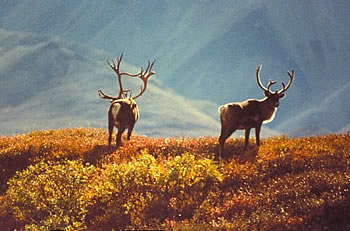Arctic Tundra
Click on image for full size
US Fish and Wildlife Service
The Arctic tundra, vast plains filled with grasses, flowers, mosses and lichen, is located north of the taiga forests in Earth’s north polar region. Like all types of tundra, this is a very cold and windy place. There is little precipitation. Most of the precipitation is snow which insulates the small plants and ground dwelling animals from the cold.
Winter in the Arctic tundra is long, dark, and very cold with temperatures as low as -70°C (-94°F) at times. However, during the short summer growing season, temperatures climb above freezing, thawing the top layer of the frozen soil - the permafrost - for a few weeks. The ground becomes saturated with the water that had been frozen all winter in the permafrost. The water forms ponds and marshes that pepper the barren landscape during the short summer. With water and milder temperatures, the Arctic tundra becomes full of life each summer.
There are no trees in the Arctic tundra; however, there are many different species of plants including small shrubs, grasses and sedges, mosses, and flowers. There are also many types of lichens. The plants that can survive in this extreme climate have adaptations that protect them from cold temperatures, such as grouping together and staying short. They can photosynthesize at low temperatures and low light intensities. Some plants even have fine hairs along their stems that keep them warm.
Many animals, like caribou, insects and many birds, migrate into the Arctic tundra from lower latitudes during the Arctic summer. Other animals, such as the Arctic hare, musk ox, and ptarmigan, have adaptations that allow them to survive the fierce conditions of the Arctic tundra year-round. Adaptations to the Arctic tundra include thick fur or feathers for warmth. Some animals have fur or feathers that turn white in color during the winter to camouflage against the white snow, and then become darker during summer. Many animals, especially those that stay in the tundra year-round, have the ability to form thick layers of fat on their bodies during summer when food is plentiful. The fat serves as insulation from the cold, and is converted to energy during the winter when food is scarce. Many of the animals that remain in the arctic tundra during the winter hibernate, which allows them to not eat at all during the winter.

